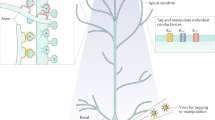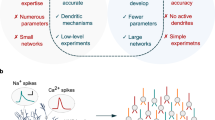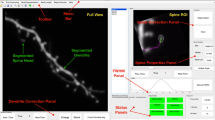Abstract
Recent technical advances have made possible the visualization and genetic manipulation of individual dendritic trees. These studies have led to the identification and characterization of molecules that are important for different aspects of dendritic development. Although much remains to be learned, the existing knowledge has allowed us to take initial steps toward a comprehensive understanding of how complex dendritic trees are built. In this review, we describe recent advances in our understanding of the molecular mechanisms underlying dendritic morphogenesis, and discuss their cell-biological implications.
This is a preview of subscription content, access via your institution
Access options
Subscribe to this journal
Receive 12 print issues and online access
$209.00 per year
only $17.42 per issue
Buy this article
- Purchase on Springer Link
- Instant access to full article PDF
Prices may be subject to local taxes which are calculated during checkout


Similar content being viewed by others
References
Cajal, S. R. Histology of the Nervous System of Man and Vertebrates (Oxford Univ. Press, Oxford, 1995).
Hausser, M., Spruston, N. & Stuart, G. J. Diversity and dynamics of dendritic signaling. Science 290, 739–744 (2000).
Cowan, W. M. The emergence of modern neuroanatomy and developmental neurobiology. Neuron 20, 413–426 (1998).
Lo, D. C., McAllister, A. K. & Katz, L. C. Neuronal transfection in brain slices using particle-mediated gene transfer. Neuron 13, 1263–1268 (1994).
Arnold, D., Feng, L., Kim, J. & Heintz, N. A strategy for the analysis of gene expression during neural development. Proc. Natl. Acad. Sci. USA 91, 9970–9974 (1994).
Dailey, M. E. & Smith, S. J. The dynamics of dendritic structure in developing hippocampal slices. J. Neurosci. 16, 2983–2994 (1996).
Wu, G.-Y. & Cline, H. T. Stablization of dendritic arbor structure in vivo by CaMKII. Science 279, 222–226 (1998).
Gao, F. B., Brenman, J. E., Jan, L. Y. & Jan, Y. N. Genes regulating dendritic outgrowth, branching, and routing in Drosophila. Genes Dev. 13, 2549–2561 (1999).
Lee, T. & Luo, L. Mosaic analysis with a repressible cell marker for studies of gene function in neuronal morphogenesis. Neuron 22, 451–461 (1999).
Banker, G. A. & Cowan, W. M. Further observations on hippocampal neurons in dispersed cell culture. J. Comp. Neurol. 187, 469–493 (1979).
Polleux, F., Morrow, T. & Ghosh, A. Semaphorin 3A is a chemoattractant for cortical apical dendrites. Nature 404, 567–573 (2000).
Craig, A. M. & Banker, G. Neuronal polarity. Annu. Rev. Neurosci. 17, 267–310 (1994).
Wässle, H., Peichl, L. & Boycott, B. B. Dendritic territories of cat reginal ganglion cells. Nature 292, 344–345 (1981).
Bradke, F. & Dotti, C. G. Establishment of neuronal polarity: lessons from cultured hippocampal neurons. Curr. Opin. Neurobiol. 10, 574–581 (2000).
Lüscher, C., Nicoll, R. A., Malenka, R. C. & Muller, D. Synaptic plasticity and dynamic modulation of the postsynpatic membrane. Nat. Neurosci. 3, 545–550 (2000).
Matus, A. Actin-based plasticity in dendritic spines. Science 290, 754–758 (2000).
Jontes, J. D. & Smith, S. J. Filopodia, spines and the generation of synpatic diversity. Neuron 27, 11–14 (2000).
McAllister, A. K. Cellular and molecular mechanisms of dendrite growth. Cereb. Cortex 10, 963–973 (2000).
Nedivi, E., Wu, G. Y. & Cline, H. T. Promotion of dendritic growth by CPG15, an activity-induced signaling molecule. Science 281, 1863–1866 (1998).
Lein, P., Johnson, M., Guo, X., Rueger, D. & Higgins, D. Osteogenic protein-1 induces dendritic growth in rat sympathetic neurons. Neuron 15, 597–605 (1995).
McAllister, A. K., Lo, D. C. & Katz, L. C. Neurotrophins regulate dendritic growth in developing visual cortex. Neuron 15, 791–803 (1995).
McAllister, A. K., Katz, L. C. & Lo, D. C. Neurotrophin regulation of cortical dendritic growth requires activity. Neuron 17, 1057–1064 (1996).
Horch, H. W., Kruttgen, A., Portbury, S. D. & Katz, L. C. Destabilization of cortical dendrites and spines by BDNF. Neuron 23, 353–364 (1999).
Barbacid, M. Neurotrophic factors and their receptors. Curr. Opin. Cell Biol. 7, 148–155 (1995).
McAllister, A. K., Katz, L. C. & Lo, D. C. Opposing roles for endogenous BDNF and NT-3 in regulating cortical dendritic growth. Neuron 18, 767–778 (1997).
Fryer, R. H. et al. Developmental and mature expression of full-length and truncated TrkB receptors in the rat forebrain. J. Comp. Neurol. 374, 21–40 (1996).
Yacoubian, T. A. & Lo, D. C. Truncated and full-length TrkB receptors regulate distinct modes of dendritic growth. Nat. Neurosci. 3, 342–349 (2000).
Gundersen, R. W. & Barrett, J. N. Neuronal chemotaxis: chick dorsal-root axons turn toward high concentrations of nerve growth factor. Science 206, 1079–1080 (1979).
Tessier-Lavigne, M. & Goodman, C. S. The molecular biology of axon guidance. Science 274, 1123–1133 (1996).
Luo, Y., Raible, D. & Raper, J. A. Collapsin: a protein in brain that induces the collapse and paralysis of neuronal growth cones. Cell 75, 217–227 (1993).
Messersmith, E. K. et al. Semaphorin III can function as a selective chemorepellent to pattern sensory projections in the spinal cord. Neuron 14, 949–959 (1995).
Song, H. J. et al. Conversion of neuronal growth cone responses from repulsion to attraction by cyclic nucleotides. Science 281, 1515–1518 (1998).
Giger, R. J., Wolfer, D. P., De Wit, G. M. & Verhaagen, J. Anatomy of rat semaphorin III/collapsin-1 mRNA expression and relationship to developing nerve tracts during neuroembryogenesis. J. Comp. Neurol. 375, 378–392 (1996).
Polleux, F., Giger, R. J., Ginty, D. D., Kolodkin, A. L. & Ghosh, A. Patterning of cortical efferent projections by semaphorin-neuropilin interactions. Science 282, 1904–1906 (1998).
Gertler, F. B. et al. enabled, a dosage-sensitive suppressor of mutations in the Drosophila Abl tyrosine kinase, encodes an Abl substrate with SH3 domain-binding properties. Genes Dev. 9, 521–533 (1995).
Wills, Z., Bateman, J., Korey, K. A., Comer, A. & Van Vactor, D. The tyrosine kinase Abl and its substrate enabled collaborate with the receptor phosphatase Dlar to control motor axon guidance. Neuron 22, 301–312 (1999).
Bashaw, G. J., Kidd, T., Murray, D., Pawson, T. & Goodman, C. S. Repulsive axon guidance: Abelson and Enabled play opposing roles downstream of the roundabout receptor. Cell 101, 703–715 (2000).
Lanier, L. M. & Gertler, F. B. From Abl to actin: Abl tyrosine kinase and associated proteins in growth cone motility. Curr. Opin. Neurobiol. 10, 80–87 (2000).
Bray, D. Branching patterns of individual sympathetic neurons in culture. J. Cell Biol. 56, 702–712 (1973).
O'Leary, D. D. M. & Terashima, T. Cortical axons branch to multiple subcortical targets by interstitial axon budding: implications for target recognition and “waiting periods.” Neuron 1, 901–910 (1988).
Yu, W., Ahmad, F. J. & Baas, P. W. Microtubule fragmentation and partitioning in the axon during collateral branch formation. J. Neurosci. 14, 5872–5884 (1994).
Zakharenko, S. & Popov, S. Dynamics of axonal microtubules regulate the topology of new membrane insertion into the growing neurites. J. Cell Biol. 16, 1077–1086 (1998).
Luo, L. Rho GTPases in neuronal morphogenesis. Nat. Rev. Neurosci. 1, 173–180 (2000).
Redmond, L. & Ghosh, A. The role of Notch and Rho GTPase signaling in the control of dendritic development. Curr. Opin. Neurobiol. 11, 111–117 (2001).
Li, Z., Van Aelst, L. & Cline, H. T. Rho GTPases regulate distinct aspects of dendritic arbor growth in Xenopus central neurons in vivo. Nat. Neurosci. 3, 217–225 (2000).
Wong, W. T., Faulkner-Jones, B., Sanes, J. R. & Wong, R. O. L. Rapid dendritic remodeling in the developing retina: dependence on neurotransmission and reciprocal regulation by Rac and Rho. J. Neurosci. 20, 5024–5036 (2000).
Luo, L. et al. Differential effects of the Rac GTPase on Purkinje cell axons and dendritic trunks and spines. Nature 379, 837–840 (1996).
Nakayama, A. Y., Harms, M. B. & Luo, L. Small GTPases Rac and Rho in the maintenance of dendritic spines and branches in hippocampal pyramidal neurons. J. Neurosci. 20, 5329–5338 (2000).
Prokop, A., Uhler, J., Roote, J. & Bate, M. The kakapo mutation affects terminal arborization and central dendritic sprouting of Drosophila motorneurons. J. Cell Biol. 143, 1283–1294 (1998).
Gregory, S. L. & Brown, N. H. Kakapo, a gene required for adhesion between and within cell layers in drosophila, encodes a large cytoskeletal linker protein related to plectin and dystrophin. J. Cell Biol. 143, 1271–1282 (1998).
Strumpf, D. & Volk, T. Kakapo, a novel cytoskeletal-associated protein is essential for the restricted localization of the neuregulin-like factor, vein, at the muscle-tendon junction site. J. Cell Biol. 143, 1259–1270 (1998).
Fuchs, E. & Yang, Y. Crossroads on cytoskeletal highways. Cell 98, 547–550 (1999).
Van Vactor, D., Sink, H., Fambrough, D., Tsoo, R. & Goodman, C. S. Genes that control neuromuscular specificity in Drosophila. Cell 73, 1137–1153 (1993).
Kolodziej, P. A., Jan, L. Y. & Jan, Y. N. Mutations that affect the length, fasciculation, or ventral orientation of specific sensory axons in the Drosophila embryo. Neuron 15, 273–286 (1995).
Lee, S., Harris, K. L., Whitington, P. M. & Kolodziej, P. A. short stop is allelic to kakapo, and encodes rod-like cytoskeletal-associated proteins required for axon extension. J. Neurosci. 20, 1096–1108 (2000).
Wang, K. H. et al. Biochemical purification of a mammalian slit protein as a positive regulator of sensory axon elongation and branching. Cell 96, 771–784 (1999).
Gao, F. B., Kohwi, M., Brenman, J. E., Jan, L. Y. & Jan, Y. N. Control of dendritic field formation in Drosophila: the roles of flamingo and competition between homologous neurons. Neuron 28, 91–101 (2000).
Usui, T. et al. Flamingo, a seven-pass transmembrane cadherin, regulates planar cell polarity under the control of Frizzled. Cell 98, 585–595 (1999).
Ruchhoeft, M. L., Ohnuma, S., McNeill, L., Holt, C. E. & Harris, W. A. The neuronal architecture of Xenopus retinal ganglion cells is sculpted by rho-family GTPases in vivo. J. Neurosci. 19, 8454–8463 (1999).
Lee, T., Winter, C., Marticke, S. S., Lee, A. & Luo, L. Essential roles of Drosophila RhoA in the regulation of neuroblast proliferation and dendritic but not axonal morphogenesis. Neuron 25, 307–316 (2000).
Kimura, K. et al. Regulation of myosin phosphatase by Rho and Rho-associated kinase (Rho-kinase). Science 273, 245–248 (1996).
Winter, C. G. et al. Drosophila Rho-associated kinase (Drok) links frizzled-mediated planar cell polarity signaling to the actin cytoskeleton. Cell (in press).
Hirose, M. et al. Molecular dissection of the Rho-associated protein kinase (p160ROCK)-regulated neurite remodeling in neuroblastoma N1E-115 cells. J. Cell Biol. 141, 1625–1636 (1998).
Sestan, N., Artavanis-Tsakonas, S. & Rakic, P. Contact-dependent inhibition of cortical neurite growth mediated by notch signaling. Science 286, 741–746 (1999).
Redmond, L., Oh, S., Hicks, C., Weinmaster, G. & Ghosh, A. Nuclear Notch1 signaling and the regulation of dendritic development. Nat. Neurosci. 3, 30–40 (2000).
Altman, J. & Anderson, W. J. Experimental reorganization of the cerebellar cortex. I. Morphological effects of elimination of all microneurons with prolonged x-irradiation started at birth. J. Comp. Neurol. 146, 355–406 (1972).
Rakic, P. & Sidman, R. L. Organization of cerebellar cortex secondary to deficit of granule cells in weaver mutant mice. J. Comp. Neurol. 152, 133–162 (1973).
Baptista, C. A., Hatten, M. E., Blazeski, R. & Mason, C. A. Cell-cell interactions influence survival and differentiation of purified Purkinje cells in vitro. Neuron 12, 243–260 (1994).
Segal, I., Korkotian, I. & Murphy, D. D. Dendritic spine formation and pruning: common cellular mechanisms? Trends Neurosci. 23, 53–57 (2000).
Morrison, M. E. & Mason, C. A. Granule neuron regulation of Purkinje cell development: striking a balance between neurotrophin and glutamate signaling. J. Neurosci. 18, 3563–3573 (1998).
Hirai, H. & Launey, T. The regulatory connection between the activity of granule cell NMDA receptors and dendritic differentiation of cerebellar Purkinje cells. J. Neurosci. 20, 5217–5224 (2000).
Fischer, M., Kaech, S., Knutti, D. & Matus, A. Rapid actin-based plasticity in dendritic spines. Neuron 20, 847–854 (1998).
Peters, A., Palay, S. L. & Webster, H. D. The Fine Structure of the Nervous System: Neurons and Their Supporting Cells (Oxford Univ. Press, New York, 1991).
Hall, A. Rho GTPases and the actin cytoskeleton. Science 279, 509–514 (1998).
Caceres, A., Mautino, J. & Kosik, K. S. Suppression of MAP2 in cultured cerebellar macroneurons inhibits minor neurite formation. Neuron 9, 607–618 (1992).
Sharp, D. J. et al. Identification of a microtubule-associated motor protein essential for dendritic differentiation. J. Cell Biol. 138, 833–843 (1997).
Yu, W. et al. Depletion of a microtubule-associated motor protein induces the loss of dendritic identity. J. Neurosci. 20, 5782–5791 (2000).
Liu, Z., Steward, R. & Luo, L. Drosophila Lis1 is required for neuroblast proliferation, dendritic elaboration and axonal transport. Nat. Cell Biol. 2, 776–783 (2000).
Smith, D. S. et al. Regulation of cytoplasmic dynein behaviour and microtubule organization by mammalian Lis1. Nat. Cell Biol. 2, 767–775 (2000).
Niethammer, M. et al. Nudel is a novel Cdk5 substrate that associates with LIS1 and cytoplasmic dynein. Neuron 28, 697–711 (2000).
Sasaki, S. et al. A LIS1/NUDEL/cytoplasmic dynein heavy chain complex in the developing and adult nervous system. Neuron 28, 681–696 (2000).
Nikolic, M., Chou, M. M., Lu, W., Mayer, B. J. & Tsai, L. H. The p35/Cdk5 kinase is a neuron-specific Rac effector that inhibits Pak1 activity. Nature 395, 194–198 (1998).
Le Roux, P., Behar, S., Higgins, D. & Charette, M. OP-1 enhances dendritic growth from cerebral cortical neurons in vitro. Exp. Neurol. 160, 151–163 (1999).
Cantallops, I., Haas, K. & Cline, H. T. Postsynaptic CPG15 promotes synaptic maturation and presynaptic axon arbor elaboration in vivo. Nat. Neurosci. 3, 1004–1011 (2000).
Davies, A. M. Neurotrophins: neurotrophic modulation of neurite growth. Curr. Biol. 10, R198–200 (2000).
Nakamura, F., Kalb, R. G. & Strittmatter, S. M. Molecular basis of semaphorin-mediated axon guidance. J. Neurobiol. 44, 219–229 (2000).
Atwal, J. K., Massie, B., Miller, F. D. & Kaplan, D. R. The TrkB-Shc site signals neuronal survival and local axon growth via MEK and P13-kinase. Neuron 27, 265–277 (2000).
Ichinose, T. & Snider, W. D. Differential effects of TrkC isoforms on sensory axon outgrowth. J. Neurosci. Res. 59, 365–371 (2000).
Giniger, E. A role for Abl in Notch signaling. Neuron 20, 667–681 (1998).
Threadgill, R., Bobb, K. & Ghosh, A. Regulation of dendritic growth and remodeling by Rho, Rac, and Cdc42. Neuron 19, 625–634 (1997).
Bito, H. et al. A critical role for a Rho-associated kinase, p160ROCK, in determining axon outgrowth in mammalian CNS neurons. Neuron 26, 431–441 (2000).
Pfister, K. K. Cytoplasmic dynein and microtubule transport in the axon: the action connection. Mol. Neurobiol. 20, 81–91 (2000).
Zou, D. J. & Cline, H. T. Postsynaptic calcium/calmodulin-dependent protein kinase II is required to limit elaboration of presynaptic and postsynaptic neuronal arbors. J. Neurosci. 19, 8909–8918 (1999).
Gertler, F. B., Niebuhr, K., Reinhard, M., Wehland, J. & Soriano, P. Mena, a relative of VASP and Drosophila Enabled, is implicated in the control of microfilament dynamics. Cell 87, 227–239 (1996).
Reinhard, M. et al. The proline-rich focal adhesion and microfilament protein VASP is a ligand for profilins. EMBO J. 14, 1583–1589 (1995).
Vaessin, H. et al. prospero is expressed in neuronal precursors and encodes a nuclear protein that is involved in the control of axonal outgrowth in Drosophila. Cell 67, 941–953 (1991).
Doe, C. Q., Chu-LaGraff, Q., Wright, D. M. & Scott, M. P. The prospero gene specifies cell fates in the Drosophila central nervous system. Cell 65, 451–464 (1991).
Brand, A. H. & Perrimon, N. Targeted gene expression as a means of altering cell fates and generating dominant phenotypes. Development 118, 401–415 (1993).
Acknowledgements
We thank Y.-N. Jan, S. Smith, A. Goldstein and J. Ng for their comments on this review. Work in our lab is supported by grants from the NIH.
Author information
Authors and Affiliations
Corresponding author
Rights and permissions
About this article
Cite this article
Scott, E., Luo, L. How do dendrites take their shape?. Nat Neurosci 4, 359–365 (2001). https://doi.org/10.1038/86006
Received:
Accepted:
Issue Date:
DOI: https://doi.org/10.1038/86006
This article is cited by
-
The developmental neurotoxicity of legacy vs. contemporary polychlorinated biphenyls (PCBs): similarities and differences
Environmental Science and Pollution Research (2020)
-
An Antagonistic Axon-Dendrite Interplay Enables Efficient Neuronal Repair in the Adult Zebrafish Central Nervous System
Molecular Neurobiology (2019)
-
CNTNAP2 stabilizes interneuron dendritic arbors through CASK
Molecular Psychiatry (2018)
-
In vivo and in vitro sex differences in the dendritic morphology of developing murine hippocampal and cortical neurons
Scientific Reports (2017)
-
Distinct effects on the dendritic arbor occur by microbead versus bath administration of brain-derived neurotrophic factor
Cellular and Molecular Life Sciences (2017)



